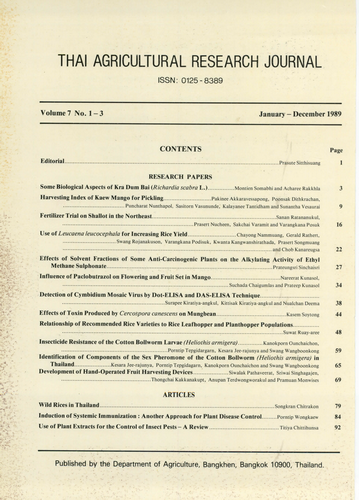Fertilizer Trial on Shallot in the Northeast
Abstract
Indications from shallot fertilizer experiment in Renu soil of Sisaket Horticultural Research Center was tested in farmer’s field at five locations in Sisaket province. The sites at Amphoe Muang and Rasisalai were on Renu soil, the two sites at Yangchumnoi were on Roi-Et soil and the site at Kunthararom was San-Pa-Tong soil. The sites on Roi-Et and Renu soil have been under shallot cultivation for 10 to 30 years and had received fertilizer treatment every year. The site on San-Pa-Tong soil was previously cropped with watermelon and has never been under shallot cultivation before. Six replications of 2 x 2 combinations between 10 and 20 kg N and P2O5 per rai plus a check treatment in randomized complete block design were used for the evaluation.
Results of the experiment showed that fertility level of the soils before planting and fertilizer application rates have a remarked effect on the yield of shallot. The soil fertility indexes highly correlated to the yield (r2= 0.985) are available Bray II-P, extractable A1 and the soil pH. The relations is Yield (kg/rai) = 11187 + Bray II-P (ppm) – 45.5 extractable A1 (ppm) – 931 soil pH. Nitrogen fertilizer application of 10 kg N per rai increased the average yield 54% from check. Nitrogen recovery by the plants was 17.5%. Application of more than 10 kg N per rai did not increase the yield except in the soils that had organic matter content less than 0.5 percent. Shallot showed high response to phosphorus applications. The average yield increased 48 and 58 percent from check with the application of 10 and 20 kg P2O5 per rai, respectively. The P recovery from the application of 10 and 20 kg P2O5 per rai was 7.8 and 4.6 percent, respectively. In the soil that had available phosphorus content more than 60 ppm, fertilizer application rate of 10 kg P2O5 per rai was adequate for shallot.
Downloads
Published
How to Cite
Issue
Section
License

This work is licensed under a Creative Commons Attribution-NonCommercial-NoDerivatives 4.0 International License.
Thai Agricultural Research Journal



